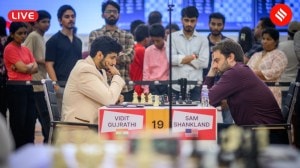Urban,Ugly
Ungainly footbridges,water bodies without water and outlandish buildings. Much of what urban India is building scores low in utility and even lower in aesthetics. The Sunday Express takes a look at some of the eyesores
THE SELF-DRAINING POOL Chandigarh
Of the several additions to Chandigarhs landscape made by UT Administrator S.F. Rodriguez,whose tenure ended recently,the most appalling is an artificial lake. Developed at a cost of Rs 3.2 crore in Sector 42 of the city,the so-called lake is a stagnant pool with no water supply of its own. Opened to the public in June last year,the lake,spread over 3.25 acres,is perhaps the only
one in the country that has to be filled with potable water from time to time.
Soon after the three-foot-deep artificial lake was constructed,the administration realised that there was a seepage problem in its concrete base. The water just wouldnt stand and an embarrassed administration had to fill it with potable water from municipality tubewells. But barely a few hours after the lake is filled with water,it would seep out,leaving the lake dry most of the time.
The administration justified the construction of the lake saying that since Sukhna lake,one of Chandigarhs best-loved public spots,is located in the northernmost part of the city,the new water body would serve as a recreational area for people living in the southern sectors. The lake even has decks intended for Chhat puja and other rituals.
But with heaps of construction material lying around till recently and unhygienic conditionsthere is a stench in the air and it is not uncommon to find plastic refuse in and around the waterpeople have largely kept away.
For the southern sectors,the lake has only brought worries about an impending water shortage in summer. S.P. Malhotra,a former chief engineer of Haryana,says,The design of the lake is unsatisfactory. The bed has to be made seepage-proof.
Home Secretary Ram Niwas,however,says most of the problems are arising because the lake is still very new. He is confident that they will be sorted out in due course of time.
Dinker Vashisht(hr)
THE GIANT YELLOW CATERPILLAR MUMBAI
Mumbaikars call the Bandra skywalk the giant,ugly,yellow caterpillar. The skywalk,stretching from Bandra East to the posh Bandra Kurla Complex,is just the first in a series of such skywalks that are being built all over the city near railway stations. The aim: to ease congestion on the roads and provide dedicated pedestrian space. Noble. But there are problems. And a lot of it has to do with the skywalks length1.3 km. Thats too long for people to walk from one end to the other,so two-thirds of the pedestrians exit the skywalk at its first arm,which descends at Bandra Court,about 300 metres after Bandra East. That leaves a large stretch of the skywalk largely unused.
After inaugurating the first skywalk in Bandra in June 2008,the Mumbai Metropolitan Region Development Authority (MMRDA) began building 51 others in Mumbai and its outback metropolitan region. The MMRDA has also proposed a skywalk in South Mumbai that would wind through the heritage mile of DN Road as well as connect Chhatrapati Shivaji Terminus with Churchgate,Mantralaya,Vidhan Bhavan and Regal Cinema. That proposal has hit a roadblock with activists protesting that it would mar the view of the areas Grade-I heritage structures. Sharada Dwivedi,historian and heritage activist,says,The skywalks are also unfriendly to the physically challenged,children and senior citizens.
The MMRDA says it sees little wrong with either the design or the aesthetics. We decide on the colour scheme and design after going through the options that the consultants give us. How can you say they are ugly? asks A.K. Pahal,additional chief engineer with the MMRDA.
The total cost of building these skywalks is pegged at Rs 600 crore but the footfalls on the ones where they have been commissioned already is not much,admits a study by the Mumbai Transformation Support Unit,the state governments think-tank for the proposed Mumbai Makeover.
According to Dwivedi,there seems to be little research conducted on whether South Mumbai needs skywalks since the footpaths here are quite wide and without encroachments,unlike in the suburbs. The ones in the suburbs are hanging on peoples heads. They are terribly designed, she says.
Swapnil Rawal(hr)
THE FOOT-OVER HULKS DELHI
Shaded by material that could pass off as a shade of dirty white and hemmed in by blindingly bright aluminium strips,is the promise of safe passage across Delhis deadly traffic.
These,the citys foot-overbridges,are the latest obsession for the Public Works Department of the Delhi Government. The target is to build 42 such bridges in time for the Commonwealth Games. A noble idea,if only the structures were not so ugly,designed with disproportionately long flights of stairs and marring the skyline.
The bridges come in two colours: a tired green for the older metal bridges,and an off-white aluminium structure for the new bridges. The PWD employs its engineers,not architects,to design the bridges. Situated at prime locations in the city,the bridges have been criticised as bulky,awkward,and downright ugly.
The first bridges,costing Rs 120-200 lakh,were hugely unpopular. Outside the All India Institute of Medical Sciences,jaywalkers continue to risk their lives by darting across the road.
New bridges,like the one at the ITO crossing,have come up with shiny innovationsescalators. Eight such bridges with escalators are coming up in the city,including in places with high visibility: Ashok Vihar,Brittania Chowk,Mansarover Garden. In the pipeline are foot-overbridges with lifts.
We are aware that the bridges are bulky. But this is to make sure they are safe and shock-proof,since Delhi sits on a seismic zone, says a senior PWD officer.
While every structure in Delhi,and even alterations to structures on public roads,need to be cleared by the Delhi Urban Arts Commission,the PWD has not approached the DUAC for the foot-overbridges. These bridges are ugly. They also force the pedestrian to go up and down,instead of getting the cars to stop for the person on foot. They should have come to us for aesthetic clearance,but the PWD has bypassed this, says K.T. Ravindran,Chairman,DUAC.
Currently,a committee with members from the Municipal Corporation of Delhi and senior members of the PWDmost typically,engineer-in-chief of PWDapproves the structures.
The cost of the project is substantialeach bridge with an escalator costs close to Rs 5 crore. A good reason why the bridges should be easy on the eye.
NEHA SINHA(hr)
The empty tall box Pune
ITS a structure that has left almost everyone who has seen it puzzled. No one is quite sure just what exactly the tall box on the busy Jungli Maharaj Road is. The citys first mechanised parking,which opened to the public in 2007,has failed to serve much of a purpose.
The aluminium-coloured and extraordinarily tall structure was constructed by the Pune Municipal Corporation (PMC). The parking is over 127 ft tall and covers an area of about 90 square metres. The entire structure is covered by meta-colour cladding and houses two lifts, says Vinayak Jadhav,junior engineer,PMC. Opened to the public in October 2007,the project took two years to be completed and cost Rs 2.4 crore. Jadhav adds,The aesthetics of the building were not as important as its operation and utility.
It isnt scoring too high on the utility front either. It has a parking capacity of 80 cars but there are never more than 10 cars around. Earlier the Jungli Maharaj Road had free roadside parking and no one really bothered to spend a penny on parking. This has continued even though the PMC now charges for roadside parking, says Hemant Chhaparwal,caretaker of the parking lot.
Constructed by Ramratna Infrastructure Private Limited,not only has the parking lot been running into losses,it has also invited the citizens ire for becoming a blot in an area that was earlier part of the picturesque Sambhaji Park.
This is the first-ever mechanised parking in the city and everybody was curious to see it. It could have been designed as a glass structure like most modern-day buildings. Along with multi-coloured cars seen through the glass,it would have made a picturesque sight. Not only that,it could have been developed into an automobile centre with facilities such as car wash. It could have had a café, says Vishwas Kanekar,beautification consultant who also worked on the Commonwealth Youth Games held in Pune last year. What it actually is,however,is a rickety-looking metal box.
Pranav Kulkarni(hr)
expert comment
Snehanshu Mukherjee
When tourists visit Amsterdam,Paris,Florence,and,closer home,Leh,Jaisalmer or Varanasi,they visit the historic core of these cities,attracted by their history and culture as manifest in their architecture. The newer parts,which usually lie on the outskirts,are quite different from the picture postcard images that we tend to associate these cities with.
New extensions are usually the opposite of the older cities. They are largely characterless. Instead of buildings defining the urbanscape,we get plots delineated by boundary walls. The main reason for such unattractive urban images is that what was traditionally known as a city has been replaced by a model put forward in 1925 by the Swiss architect Le Corbusier. He proposed to do away with Paris as we know it. In its place,he wished to erect tall buildings akin to the tower blocks that housing societies and real estate developers have been constructing in and around New Delhi in places such as Dwarka,Gurgaon,Ghaziabad or NOIDA. This is the unfortunate model followed today in all Indian cities.
Hence we have done away completely with the traditional city form in favour of a planned,over-simplified city of roads and plots. Such planned citiesNew Delhi is a prime examplecreate exclusive precincts where only the rich and powerful can stay.
A city of plots,where buildings are separated from each other,create individualistic and non-contextual architecture. The plot setbacks dictated by our Master Plans ensure that there are always left-over spaces in between to isolate the buildings. The city,therefore,becomes a collection of strangely shaped boxes sitting individually and egotisticallya perfect setting to show off our prowess in designing a city of multiple icons.
One of the ways to understand the difference between traditional and contemporary architecture is to understand their source of aesthetic inspiration. The Industrial Age has changed our aesthetic references to machines. In contrast,the pre-industrialised world looked towards nature as its primary source of inspiration.
Shock and awe seems to be the design intention behind every building that makes it to the global headlines. The wow factor as seen in Frank Gehrys Bilbao Museum in Spain appears to be more important than aesthetic considerations in the making of architecture today. This sets the benchmark,which hundreds of other architects validate through thoughtless imitation.
Pandering to instant gratification,however,does not produce instant Taj Mahals. Even in this age of over-hyped creations,the Taj still has the capability to overwhelm ones senses. There are many examples of such sophistication from across the country,though mostly from the past. These buildings,whether they are the havelis of Jodhpur or the Padmanabhapuram Palace in Kerala,represent a highly evolved culture.
If I am to answer the question,what is this architecture of culture,I would say:
* That which addresses the aspirations of the people and the context of the place that we design in,appropriately and completely.
* That which harmonises with the site and its climate and does not work against it.
* A design that conserves and wisely uses precious natural resources such as water,tree cover,metals,minerals and energy sources.
Unfortunately,modern architecture,as it is practised,very rarely addresses these issues. This is why we have cities today whose efforts at portraying themselves as progressive only result in grotesque buildings,wide dusty treeless roads,massive or ungainly foot-bridges,almost no pavements,incomprehensible signboardsall incidentally touted as cutting-edge design.
In reality,it is mostly designs from the past that are the best examples of the current buzzsustainable architecture. Our culture of those days had to be sustainable,since there was no other way to live in a pre-industrial economy. The simplest description of sustainable and culture-specific architecture was given by Mahatma Gandhi when his hut was to be constructed at the Wardha Ashram. He had said that the hut should be constructed with resources that were locally available.
However,the architecture we are taught and that most of us practise today is a product of the post-industrialised eraan economic condition that is driven by selling more than the demand,therefore creating conditions for us to consume and waste even more.
The answer,therefore,lies in creating an architecture that belongs to the place and its people and therefore,to the culture of the place. Contemporary architects from Sri Lanka,Kerala,Egypt,Mexico and Italy,such as Geoffrey Bawa,Laurie Baker,Hassan Fathy,Luis Barragan and Carlo Scarpa have shown the way to design anew within a cultural context.
I had started with the context of the city and I would like to end with an example that I consider to be a brilliant effort in planning and creating a modern city. Jaipur,a city built by the progressive Maharaj Sawai Jai Singh II and his architect Pandit Vidhyadhar. Its a city that was both culturally sophisticated and modern. However,we do not seem to learn from examples that are home-grown. Unfortunately,Jaipurs expansions today are like any other citysugly,ad-hoc,without character,and which could belong anywhere.
We need to introspect and ask ourselves,why did we let this happen? Isnt it time we solved our problems locally,and create relevant and contextual architecture?
Snehanshu Mukherjee is a senior architect and a visiting faculty at the School of Planning and Architecture. He also designed the New Wing of the National Gallery of Modern Art in New Delhi.



- 01
- 02
- 03
- 04
- 05




























